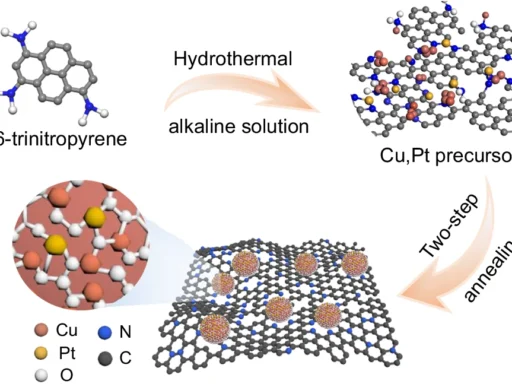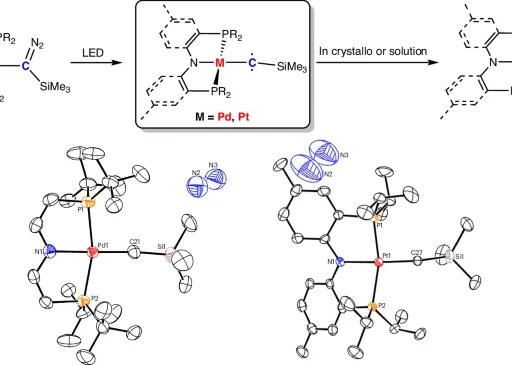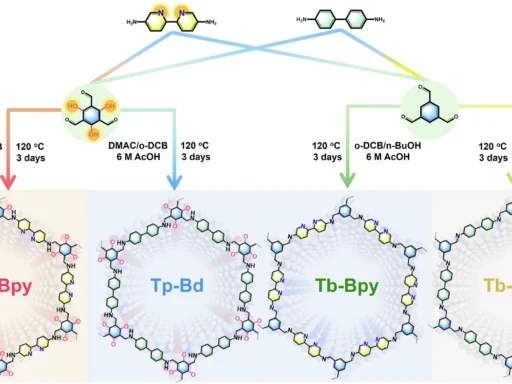Table of Contents
Overview:
Rotaxanes are a remarkable innovation in molecular chemistry, with significant potential. These mechanically linked molecules, often compared to a thread passing through a ring, captivate scientists with their distinctive structural features and diverse applications. The key to successful rotaxan assembly rests in the strategic utilization of enaminones, namely conjugated bis(enaminones). These molecules not only simplify the assembly process but also allow for a variety of alterations after synthesis, greatly improving the utility and flexibility of rotaxanes.
An Exploration into Rotaxanes:
“Definition” refers to the act of explaining the meaning of a word, phrase, or concept. It involves providing a clear and concise explanation that accurately conveys the intended meaning. The term “structure” refers to the arrangement.
Rotaxanes are molecular complexes that thread a large cyclic ring onto a linear component, commonly referred to as the “dumbbell,” with bulky groups at both ends to prevent the ring from sliding off. This distinctive configuration forms a mechanical linkage that distinguishes it from conventional covalent connections, enabling the constituents to move to one another without undergoing disassembly.
Molecular Machines and Materials Science hold significant importance:
It plays a crucial role in the field of molecular machines, which are tiny devices capable of carrying out specified functions, such as controlled motion or molecular switching. Sophisticated materials, intelligent systems, and nanotechnology can utilize their distinctive mechanical interlocking characteristics. Applications span from molecular electronics to drug delivery systems, where their dynamic character and stability are pivotal.
Historical context and evolution:
Although the emergence of supramolecular chemistry in the 1980s and 1990s led to substantial advancements, the origin of rotaxanes dates back to the early 20th century. The development of effective synthetic techniques, including template-directed synthesis and self-assembly methods, facilitated the extensive investigation and utilization of rotaxanes. Conjugated bis-enaminones threads as templates for the formation of hydrogen-bonded rotaxanes and their synthetic post-modification via double stopper-exchange protocol.

Enaminones: An Introduction
Fundamental Frameworks and Characteristics:
Enaminones are chemical compounds containing an enamine group, a nitrogen atom connected to a carbon-carbon double bond and conjugated to a ketone. Enaminones are important intermediates in chemical synthesis because of the unique electrical characteristics conferred by this conjugation. They demonstrate an equilibrium between nucleophilicity and electrophilicity, facilitating various chemical reactions.
Enaminones Synthesis:
This is how enaminones are usually made: <0xCD><0x80>-dicarbonyl compounds and primary amines are mixed through condensation. This reaction is direct and produces enaminones with outstanding efficacy and purity. Depending on the desired structure, one can customize the characteristics of the resultant enaminone by using different initial substances and circumstances.
Structure and Properties of Conjugated Bis(Enaminones):
Organic synthesis applications:
Enaminones are crucial intermediates in the synthesis of several heterocyclic compounds. Due to their high reactivity and adaptability, they are essential in medicinal chemistry for the advancement of medications and in materials science for the construction of intricate molecular structures. Additionally, their wide range of uses includes the production of natural substances and agricultural compounds.
Chemical composition:
Conjugated bis(enaminones) are composed of two enaminone units connected by a conjugated system. These templates are particularly useful for rotaxane assembly because they improve the electrical characteristics and stiffness of the structure. The conjugation expands the <0xC8>-system, enhancing stability and enabling interactions with other molecular components.
Distinctive Characteristics and Benefits:
The incorporation of conjugation in bis(enaminones) confers numerous benefits:
Rigidity and planarity: These characteristics ensure that the macrocyclic ring threads optimally, reducing entropic costs.
Increased Stability: The elongated <0xC8>-system plays a significant role in ensuring the overall stability of the molecule, which is essential for preserving the integrity of the rotaxane.
Chemical Reactivity: Conjugated bis(enaminones) can go through some different chemical reactions, which means that changes can be made to the rotaxane after it has been made.
Comparison with Alternative Templates:
When compared to alternative templates, conjugated bis (enaminones) have improved stability, ease of modification, and efficiency in rotaxane assembly. Bis(enaminones) offer a well-balanced strategy that improves both the assembly process and the functionality of the end product, whereas alternative templates may require more complicated synthesis or provide less stability. Comparison of electrostatic potential maps of threads 1a and 3a and their corresponding amide-based rotaxanes 2 and 4.
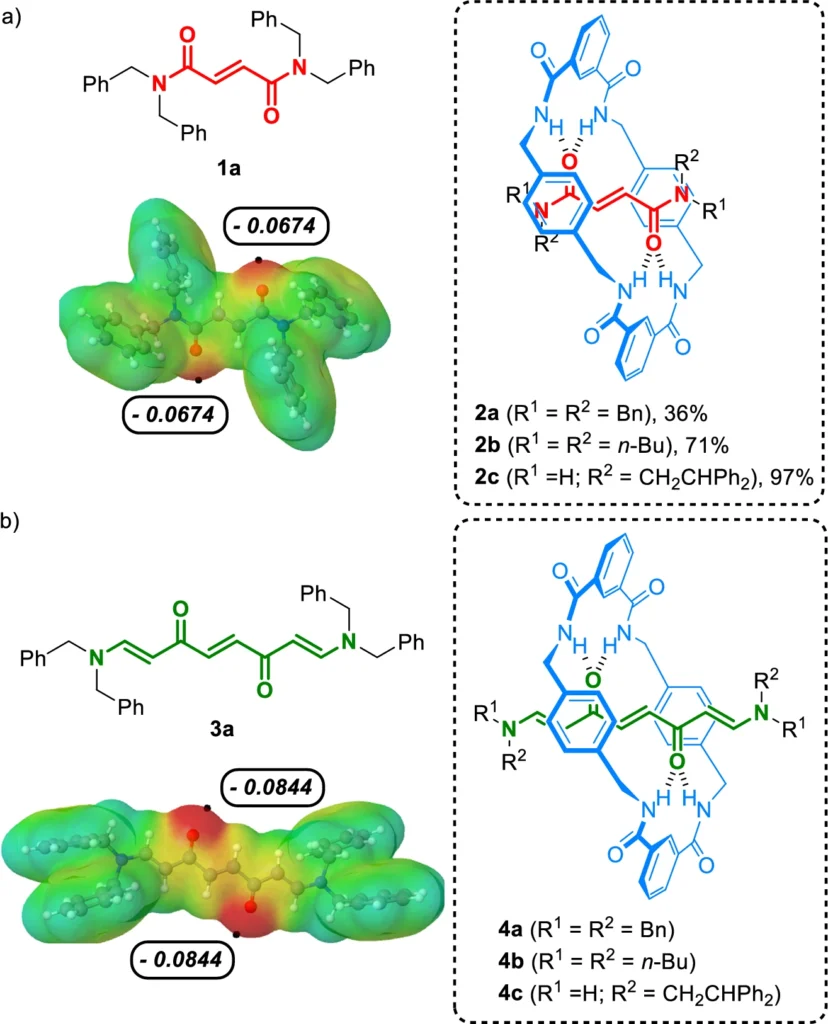
Conjugated bis(enaminones) facilitate rotation assembly:
Sequential Procedure for Assembly:
1). Conjugated Bis(Enaminone) Synthesis
The method begins with the bis(enaminone) template synthesis. The process involves condensation of suitable precursors to form the conjugated system, followed by purification to achieve optimal purity and yield.
Macrocycle ring threading
2). Threading the Macrocyclic Ring
A macrocyclic ring, typically a crown ether or cyclodextrin, threads the bis(enaminone) template. The conjugated system’s stiffness and flatness enable this threading process, ensuring effective contact between the components.
Applying a cap to the ends
3). Capping the Ends
The bis(enaminone) template affixes large stopper groups to its termini to prevent the macrocyclic ring from falling off. The stopper groups are usually large organic moieties that create steric hindrance, which helps to keep the ring in position.
Conjugated bis(enaminones) play a crucial role in the process.
Role of Conjugated Bis(Enaminones) in the Process:
The distinctive characteristics of conjugated bis(enaminones) facilitate the simplification of the rotaxane assembly process. Their inflexibility and flatness guarantee effective threading, while their chemical reactivity permits the incorporation of diverse functional groups. Due to their versatility, they are well-suited as templates for constructing robust and efficient rotaxanes.
Illustrations of Effective Assembly:
Multiple investigations have demonstrated the effective construction of rotaxanes using conjugated bis (enaminones) as templates. These examples demonstrate the effectiveness and adaptability of bis(enaminones) in facilitating the assembly process and improving the characteristics of the produced rotaxanes. For instance, studies have shown that rotaxanes built with bis(enaminones) exhibit enhanced stability and functionality in molecular machine applications. Synthesis of bis(enaminone)-based threads 3 and their corresponding hydrogen-bonded rotaxan 4.

Advantages of Using Conjugated Bis(Enaminones) in Rotaxane Assembly:
Improved Stability:
An important benefit of using conjugated bis (enaminones) is the increased stability they provide to the constructed rotaxane. The conjugated system imparts structural stiffness and planarity, hence reducing the probability of dissociation under different conditions. The rotaxane’s stability is critical for applications that require it to remain intact for extended periods.
Enhanced productivity:
The distinctive characteristics of bis(enaminones) also enhance the efficiency of the assembling process. Their inflexibility and flatness make it easier to thread the large cyclic ring, thereby reducing the time and effort required for assembly. Efficiency plays a critical role in large-scale applications, where reducing manufacturing time and costs is of utmost importance.
Flexibility in Design:
Conjugated bis(enaminones) provide a high degree of flexibility in their design, enabling rotaxanes to be tailored to specific application needs. Bis(enaminones) has a high degree of chemical reactivity, allowing for the incorporation of diverse functional groups. This capability helps to improve the characteristics and functionality of the resulting product. Bis(enaminones) possess a versatile nature, making them highly appealing for a variety of applications, including molecular machines and drug delivery systems.
After synthesis, rotaxanes undergo modifications:
We scrutinize the methods employed to alter substances following their synthesis.
The process of modifying the rotaxane’s structure after assembly to enhance its properties or add new capabilities is known as post-synthetic alterations. There are several methods to achieve these modifications, including:
Functional Group Additions: To improve rotaxane’s reactivity, solubility, or ability to interact with other molecules, functional group additions add more functional groups to its structure.
Structural Modifications: Structural modifications involve changing the main structure of the rotaxane to enhance its stability, flexibility, or ability to respond to external stimuli.
Surface Functionalization: Surface functionalization involves altering the surface of the rotaxane to improve its interaction with particular environments or materials.
The significance of modifications in improving functionality is worth considering:
Post-synthetic alterations are essential for tailoring rotaxanes to fulfill specific application prerequisites. Scientists can enhance the reactivity, stability, and utility of the rotaxane by introducing additional functional groups or modifying its structure. These alterations are especially crucial in applications like medication delivery, where the rotaxane must interact with precise biological targets or release its payload in a regulated manner. Double stopper-exchange protocol for the synthesis of rotaxanes 4c-d and shuttle 5, including shuttling via DA and retroDA reactions.

Techniques for Altering Conjugated Bis(Enaminone)-Based Rotaxan:
Introduction to Functional Group Additions:
You can improve the properties of rotaxane by adding new chemical groups to its bis(enaminone) backbone. This is called functional group addition. These enhancements can improve the rotaxane’s responsiveness, solubility, or interaction with other molecules. Bis(enaminone) –based rotaxanes often have typical functional groups attached to them.
Hydroxyl groups: improving the ability to dissolve in a solvent and form hydrogen bonds.
Carboxyl groups enhance reactivity and facilitate the process of conjugating with other molecules.
Amine groups enhance basicity and facilitate additional chemical changes.
Alterations to the structure:
To improve the stability, flexibility, or reactivity of the rotaxane, structural changes are made to the core structure of the bis(enaminone) template. There are numerous methods to achieve these modifications, such as:
Cross-Linking: The process of creating connections between the bis(enaminone) units to improve stability and rigidity.
Ring-opening reactions include the modification of a macrocyclic ring to provide new functional groups or enhance flexibility.
Substitution reactions involve replacing certain atoms or groups in the bis(enaminone) backbone to customize the characteristics of the rotaxane.
Illustrative Analysis and Instances:
Multiple investigations have shown that conjugated bis(enaminone) effectively alters rotaxanes. Researchers have added hydroxyl groups to improve the solubility and hydrogen bonding abilities of the rotaxane. In a separate investigation, researchers introduced carboxyl groups to enhance reactivity and facilitate conjugation with other compounds. These alterations have greatly improved the performance of the rotaxanes, leading to notable advancements in their use for molecular switches and sensors.
Utilizations of Altered Rotaxanes:
At the molecular level, nanomachines:
Altered rotanes are currently leading the way in the advancement of molecular machine technology. Nanoscale devices can carry out intricate functions, such as precise movement, molecular switching, and specific delivery. Scientists can modify the characteristics and functionality of rotaxanes after synthesis to satisfy specific application requirements. Scientists have used modified rotaxanes to create molecular motors and gears that can perform precise mechanical operations at the nanoscale.
Pharmaceutical delivery systems:
Rotaxanes are very good at delivering drugs because they can interlock mechanically and react chemically, which lets you precisely control how therapeutic molecules are released and where they are targeted. Scientists can improve the specificity and effectiveness of drug administration by including functional groups that interact with specific biological targets. Scientists have altered rotanes to transport anticancer medications, antibiotics, and other therapeutic substances, demonstrating their potential to improve treatment outcomes.
Highly developed materials:
Rotaxanes are currently under investigation for their ability to develop sophisticated materials that respond to environmental variations such as temperature, pH, and light. These intelligent materials have a wide range of uses in many industrial applications, including sensors, actuators, self-healing materials, and responsive coatings. After synthesis, modifying rotaxanes allows these materials to be customized to meet specific performance criteria. NMR analysis for the assessment of ring shuttling
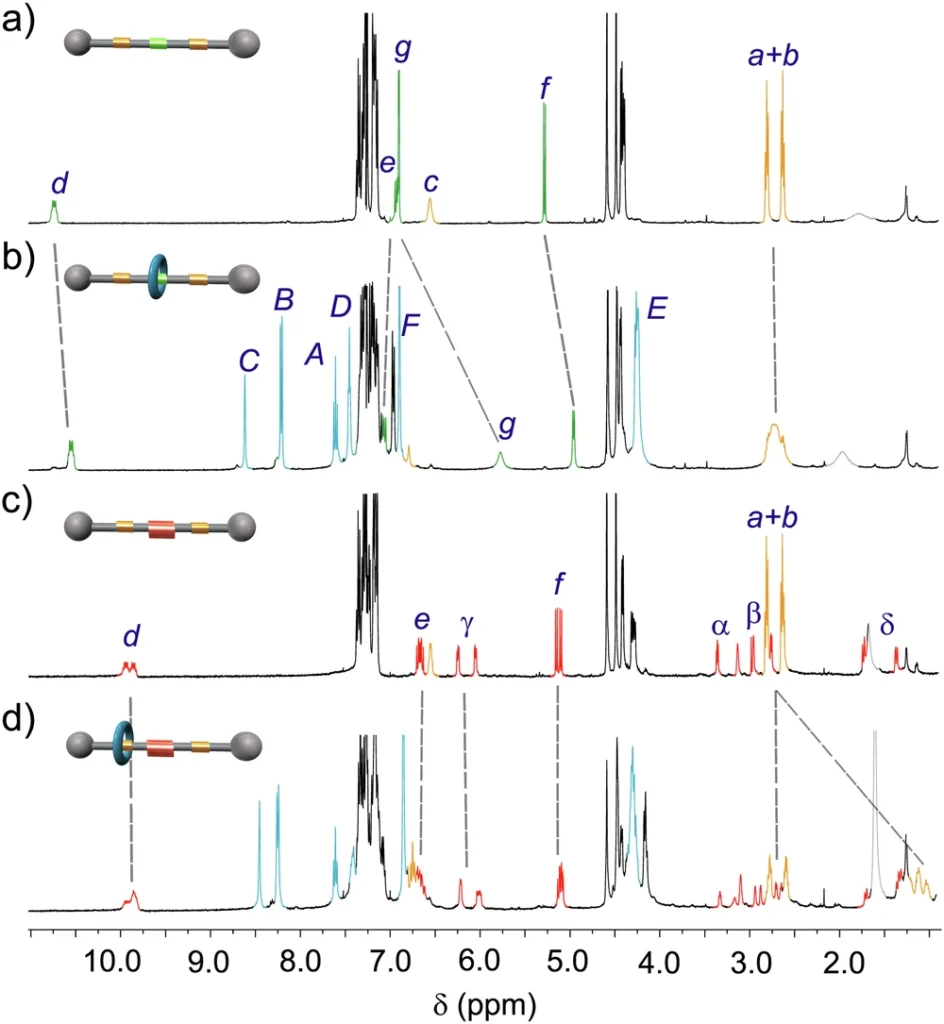
Obstacles and Restrictions:
Technical issues arose during the synthesis and modification process:
Conjugated bis(enaminones) have numerous benefits, but their synthesis and subsequent modification require meticulous control and modern technology. The assembly process consists of several sequential processes, each of which necessitates meticulous optimization to guarantee a high level of yield and purity. Furthermore, performing post-synthetic changes can be technically demanding, necessitating specialized equipment and knowledge.
Stability concerns:
Ensuring the stability of modified rotaxanes under different situations is essential for their practical utilization. Any separation of the components can weaken the rotaxane’s functionality. Researchers are now investigating techniques to improve the stability of rotaxanes, such as incorporating cross-links or developing stronger stopper groups.
Prospects for Future Research:
Current research endeavors to address these problems by advancing more resilient synthetic techniques and investigating novel approaches to modification. Researchers are now studying novel materials and methodologies to improve the stability and functionality of rotaxanes. Furthermore, we anticipate that advancements in nanotechnology and materials science will open up new possibilities and prospects for rotaxan.
Latest breakthroughs in the discipline:
Recent Research Discoveries:
Recent research has brought attention to novel techniques for producing conjugated bis(enaminones) and constructing rotaxanes. Researchers have developed template-directed synthesis strategies that improve rotaxane assembly efficiency and yield. Previous research has concentrated on employing advanced modification techniques, including click chemistry and photochemical processes, to improve the characteristics of rotaxanes.
Current developments and advancements in technology:
The topic of rotaxane chemistry is now experiencing a significant increase in attention, primarily due to advancements in nanotechnology and materials science. A current development in the field involves the integration of rotaxanes with other nanomaterials, such as carbon nanotubes and graphene, to produce hybrid systems that exhibit improved characteristics. Furthermore, researchers are exploring the potential of rotaxanes in innovative domains such as quantum computing and nanorobotics, where their unique mechanical properties can serve innovative uses.
We conducted a comparative analysis of Rotaxane templates with other templates:
Optimization and Effectiveness:
When compared to alternative templates, conjugated bis(enaminones) demonstrate enhanced efficacy in the rotaxane assembly process. Their inflexibility and flatness enable effective threading, resulting in enhanced performance in various applications. Bis(enaminones) offer a well-balanced strategy that improves both the assembly process and the functionality of the end product, whereas alternative templates may require more complex synthesis or provide less stability.
Economic efficiency:
The production of bis(enaminones) may have a higher cost compared to simpler templates; however, their effectiveness and adaptability can compensate for these costs in applications of great value. Modifying bis(enaminones) after synthesis allows rotaxanes to be customized to meet specific application requirements, increasing their overall value.
Simplicity of synthesis:
One can easily produce conjugated bis(enaminones) by directly synthesizing enaminones and then conjugating them. The ease of synthesizing bis(enaminones), along with their exceptional characteristics, makes them a highly appealing option for rotaxane assembly. Bis(enaminones) provide a more streamlined and effective method for producing high-performance rotaxan, in contrast to more intricate templates.
Prospects for the future:
Possible Uses:
Conjugated bis(enaminone)–based rotaxanes have significant potential in a variety of domains, including biology, nanotechnology, and innovative materials. Rotaxan has potential applications in biomedicine, such as targeted drug administration, diagnostics, and molecular imaging. Molecular machines and nanoscale devices could greatly benefit from their involvement in nanotechnology. Rotaxan has the potential to be used in advanced materials to fabricate intelligent materials that exhibit responsive behavior to changes in their surroundings, presenting novel opportunities for the development of sensors, actuators, and various other applications.
Projected Technological Advancements:
Scientists anticipate that progress in synthetic methodologies and a deeper understanding of rotaxane chemistry will facilitate the discovery of new applications and enhance the effectiveness of existing ones. Scientists are investigating novel substances and techniques to enhance the stability, efficiency, and utility of rotaxan. Furthermore, we anticipate that the anticipated interdisciplinary cooperation among chemists, materials scientists, and engineers will stimulate innovation and create novel prospects for them.
In conclusion:
Conjugated bis(enaminones) have become prominent structures for the construction of rotaxanes, providing improved stability, efficiency, and adaptability. Their capacity to undergo post-synthetic alterations significantly enhances their potential for use, rendering them indispensable in the domains of molecular machines, medication delivery, and innovative materials. As research progresses, the prospects of conjugated bis(enaminone)-based look highly promising.
Frequently Asked Questions:
1). What are rotaxanes and why are they important?
They are molecules that mechanically interlock by threading a macrocyclic ring onto a linear component. They are significant due to their use in molecular machines and innovative materials. Due to their distinctive structure, they possess the ability to exhibit regulated movement and dynamic activity, rendering them highly valuable in diverse domains.
2). What is the synthesis process for enaminones?
Condensation of -dicarbonyl compounds with primary amines produces enaminones, which are extremely effective and pure substances. This reaction produces flexible intermediates with a wide range of applications in organic synthesis.
3). What factors contribute to the effectiveness of conjugated bis(enaminones) as templates?
It is especially easy to put together rotaxane with conjugated bis(enaminones) because they have a rigid, flat structure and better electrical properties. These characteristics enable effective threading and enhance the stability of the formed rotaxane, hence improving its overall performance.
4). In everyday life, what are some practical uses of rotaxanes?
It finds use in molecular machinery, drug delivery systems, and the advancement of intelligent materials that can react to changes in their surroundings. Due to their dynamic nature and stability, they hold significant value in various sectors like healthcare, nanotechnology, and materials research.
5). When altering rotaxanes, what obstacles do scientists face?
The challenges encompass technical difficulties in the process of synthesizing and modifying, ensuring stability across different situations, and devising reliable techniques to improve functionality. Scientists are currently looking for innovative methods and substances to overcome these obstacles and fully utilize the capabilities of rotaxanes.
For more chemistry blogs, visit chemistry Master



